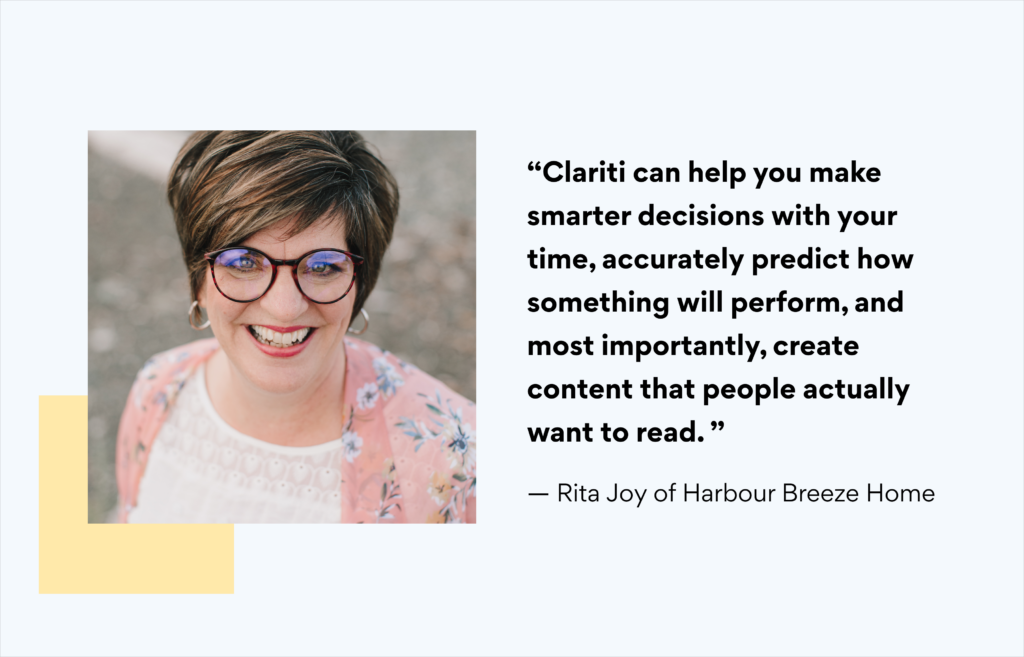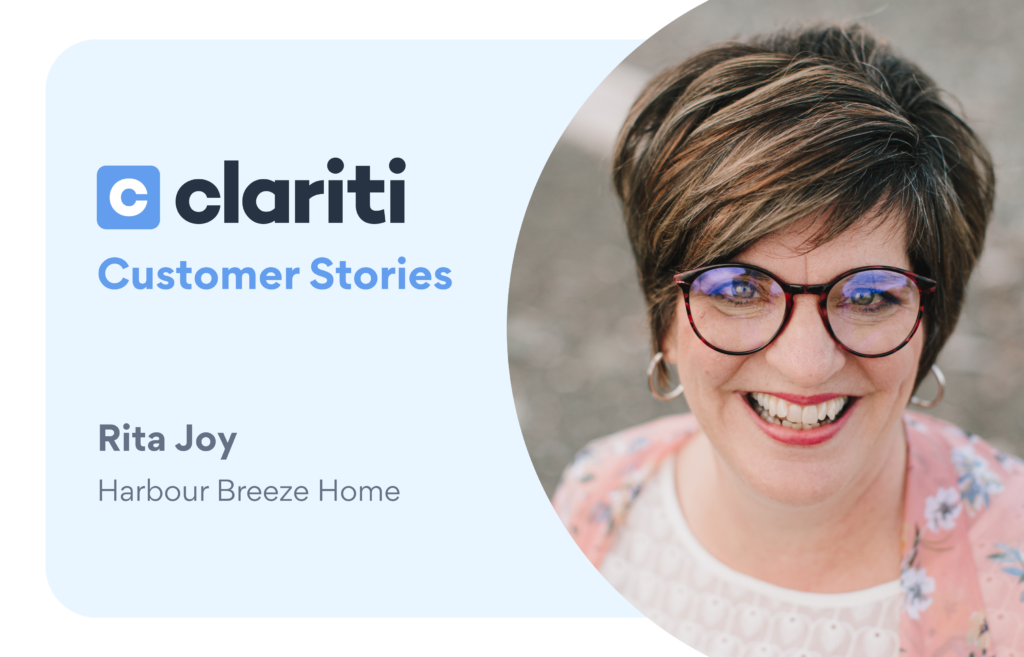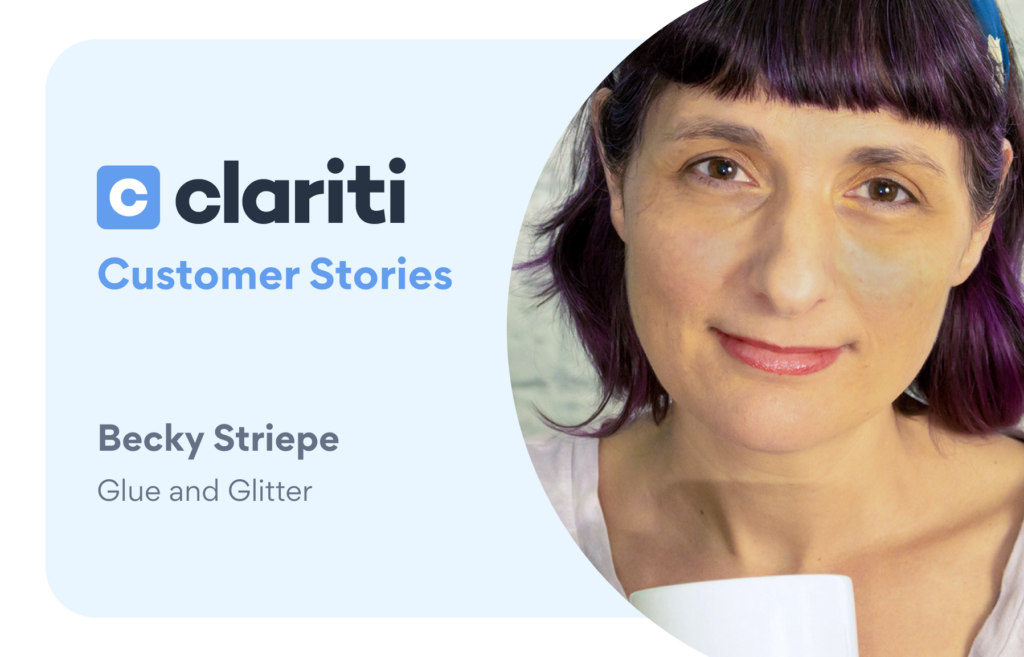It’s no secret we’re big fans of our Clariti users. We love catching up with them and getting a behind-the-scenes peek into how they organize and optimize their blog content — and use the data from Clariti to make clear decisions about their site. We thought you might be interested too, so we are sharing their stories right here on the blog.
Everyone… meet Rita!
Rita, please tell us about the site you have on Clariti.
I have a home and lifestyle blog called Harbour Breeze Home. I share simple recipes, quick DIYs, and tips to help make daily life a little easier and home a whole lot cozier.
I’ve been blogging since 2010, and have 1,382 posts and pages on Clariti.
1,382 posts? That’s impressive! Can you tell us more about your blogging journey and how you discovered Clariti?
Blogging started as a hobby for me—I had no idea I could make money from it. Eventually, I started learning about SEO and the different ways to optimize my content.
I realized if I wanted to monetize my blog, I needed to learn about the analytics side of running a business, not just the creative side. I had a ton of content that wasn’t written with SEO in mind, but I wasn’t sure which content was worth updating.
I needed a way to identify which of my older posts were valuable enough to update and continue promoting.
My business mentor introduced me to Clariti, and it’s been the perfect tool for managing my content in one place!
How did you learn how to use Clariti?
When I first started using Clariti, I didn’t understand how to use the Projects and Tabs features. I decided to read the other customer stories on Clariti’s website and they gave me a lot of great ideas.
One of the articles even showed me how to use the Explore Page to check my visitor and session percentage change over a period of time. I can’t wait to start using that feature!
How has Clariti changed the way you manage your blog content?
I use Clariti to simplify my workflow and make quicker, data-driven decisions. With Clariti, I can update a post in under fifteen minutes.
Clariti also helps me organize my content and identify gaps that could benefit from new posts. Ultimately, it’s helped me realize that optimizing old content is just as important as creating new content. I’ve never seen an updated post that didn’t perform better.
Clariti also helps me understand my community better. I share content on Google, Pinterest, Facebook, Instagram, and with my email list. By paying attention to the traffic sources for each post, I’m able to learn which kind of content each community enjoys.
With Clariti, I’ve learned:
- My recipe-related content performs best on Facebook and Google.
- My craft/DIY content performs best on Pinterest.
- My free printables perform best with my email list.
This information has been invaluable for deciding which content to update and where to promote it. For example, if a post performance skyrockets after sharing it in my newsletter, I know to feature similar posts in future emails.
What does your process for organizing and optimizing your content look like now that you have Clariti?
My goal is to update 30 blog posts per month based on what I think will perform best at that time of year.
“Since using Clariti, this is the first year where I’ve updated at least one post a day.”
I typically look at how each post is performing based on updates I’ve made in the past. I use the notes feature in Clariti to record data every time I update a post so that information is easy to access and track in the future.
I also use the Performance Page to look at where the biggest traffic sources are coming from for each post. If they’re coming from Pinterest, I know my time is better spent creating and scheduling new pins versus updating the entire post.
Thanks to the data Clariti provides, I’ve been able to make more strategic decisions about how I spend my time.
How do you choose which posts to update first?
I use the filters tab inside Clariti to help me choose which posts I should update.

My favorite filter is the “months published” filter to organize content by month or season (to see what performed well in previous years). Then I choose the posts with the highest page views to add to my content calendar to be updated and reshared for that month.
Can you walk us through your process for updating older content?
Once I decide which post I’m going to update for the day, I start by optimizing the format. I add H2 headings (I wasn’t doing that in the early days!) and make sure the keyword I’m trying to rank for is featured in the title and throughout the content.
Then I add things like recipe/how-to cards, alt tags, and inbound links. (Pro tip: the filters tab makes finding inbound links SO much easier! I use it to sort my content by topic, and pull links from the most relevant posts. It’s a huge time saver.)
I also use this time to update the value of my content. This means updating old or outdated photos, and rearranging the content so it’s more user-friendly.
If the entire post needs to be rewritten or re-photographed, I add it to a separate “rewrite” project inside Clariti to work on another time.
Which features of Clariti are your favorite?

Definitely the text filter search bar!
I love using the text filter search to organize my content by topic. This helps me create roundup posts to share on my blog and with my email list.
For example, last year I sent out a newsletter highlighting my top-performing Christmas decor posts, and my subscribers loved it! Clariti made this information so easy to find. All I had to do was type “Christmas decor” into the search bar, and all my related posts came up.
Another way I use the filters tab is to organize groups of content by performance metrics, like page views, keyword performance, and traffic sources. This helps me make more informed decisions about which content to update and which marketing channel to promote it to.
Now that you have Clariti, how do you feel about managing your blog content?
“Clariti works for me because it’s simple, easy to understand, and doesn’t feel overwhelming.”
It’s become my one-stop shop for understanding my analytics and organizing my content. I sometimes use other tools, like Google Analytics, but I can find the information I need on Clariti much faster.
With Clariti, I don’t have to think so hard.
What is the biggest way Clariti has helped you manage your blog content so far?
One of my biggest fears is that I’ll update a post and it will negatively impact its performance, but I won’t know why. Clariti’s data helps me make more informed decisions about whether a post needs updating.
If a post is doing well, I leave it alone. If it’s underperforming, Clariti helps me understand why so I can feel confident the changes I make will positively impact its performance.
Ultimately, what does Clariti provide for you now that you didn’t have before?
“Clariti has given me the freedom to embrace the creativity of being a blogger!”
I’ve never been a huge data and analytics person. It took me a while to realize that SEO and keyword research are just as important as the creativity that goes into writing the content. However, if I just focused on the analytics side of things, I’d no longer enjoy what I do.
Clariti has made balancing the data side of my business with the creative side of my business easier and more fun. Thanks to Clariti, I can update and optimize one blog post in just fifteen minutes, leaving more time for the fun stuff—like creating Instagram reels and writing email series!
If you were to recommend Clariti to a fellow content creator, what would you say?

Clariti can help you understand the value of recycling old content, and become more proactive about updating it. If you have a lot of content like I do, you need a tool like Clariti to help you manage it all.
Clariti can help you make smarter decisions with your time, accurately predict how something will perform, and most importantly, create content that people actually want to read.



